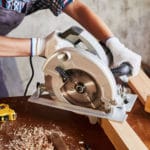Choosing the right type of chainsaw for your needs can be a daunting task. There are many factors that you should take into consideration when making this important decision, but in general electric and gas chainsaws have their own advantages and disadvantages.
We will explore these differences below so you can make an informed decision about what kind of saw to purchase for your next project.
What is an Electric Chainsaw?
An electric chainsaw is a power tool that uses an electric motor to turn a chain or blade for cutting wood. The power of the saw is usually determined by the voltage and frequency of the electricity used and the horsepower of the motor. These motors can generally be found in anything from small household tools to large industrial machines.
The electric motor within the chainsaw is usually connected to a battery pack or power cord that runs back to the house for power.
Electric chainsaws are powered by electricity, so they do not require fuel or maintenance like their gas counterparts. Storing them is easier too because you don’t have to worry about refueling them. This also means you won’t have to clog up your garage with fuel cans, oil, or other hazardous materials.
The convenience of electric chainsaws means that they are often marketed as being safer than gas-operated models. This is because the chainsaw doesn’t need to be started with a pull cord as gas models do. However, both types of saws are considered equally dangerous when used improperly.
Electric-powered saws can offer more torque for cutting thicker materials than other kinds of tools such as battery-operated or manual cutters. The average electric chainsaw can cut through wood up to 12 inches in diameter.
Electric chainsaws are typically made with plastic components instead of metal parts so they weigh less than gas models do. This makes them easier to maneuver around your cutting site and also takes the stress off your wrists if you have large trees or logs that need to be removed.
The downside to this lightweight design is that they won’t last as long or cut through materials as easily. For thicker wood, a gas chainsaw may be the better option to have around your home.
The different size and power options for electric saws also make them an attractive choice when you need to carry them from one place to another during use.
The main drawback to electric chainsaws is that the power cord limits where they can be used and how long you can use them before needing to recharge.
If there isn’t an outlet located near your wooded area, you will have to string the cord through or around it which can be time-consuming. You may even need an extension cord depending on how far away from a power source you are working.
Another thing to consider is that electric chainsaws don’t have as much torque for cutting thicker materials as gas-powered models do.
Although they are lightweight, the cord limits how long you can use them or where they can be used. If you have a large project that needs to get done quickly, it may be better to invest in a gas chainsaw instead.
What is a Gas-Powered Chainsaw?
A gas-powered chainsaw requires fuel in order to run. A gas-powered chainsaw usually takes unleaded gasoline which needs to be stored inside an attached tank when in use.
Gas-powered chainsaws are the best solution if you’re looking for a powerful cutting tool. With this type of saw, you can work with logs that weigh up to 250 pounds.
This is not always the case with electric chainsaws, so gas chainsaws offer a great advantage for those who need a powerful saw. The disadvantage of a gas chainsaw is that it requires gasoline as fuel and has to be refilled with gas whenever necessary.
A gas chainsaw is a portable power tool used for cutting through wood, wood that would otherwise be difficult to cut with an ax.
The saw’s engine and the chainsaw’s blade moves around a bar so quickly that it can cut through anything in its path. Gas chainsaws use either a two-stroke or four-stroke engine and produce emissions of exhaust gas and unburned fuel vapors.
These saws are generally stronger than their electric counterparts, but they are more expensive to buy. Gas chainsaws often require a gas tank and a spark plug in order to operate properly. These machines also produce a high volume of noise due to the motor’s use of air-cooling systems.
Generally, these types of saws are used for heavy-duty woodcutting projects such as the removal of unwanted trees from one’s property or yard.
Electric and Gas Chainsaws Comparison Table
| Electric Chainsaw | Gas Chainsaw |
|---|---|
| Ideal for basic yardwork | For home, commercial, and ranch sawing needs |
| Light, compact, and easy to carry | Heavier, not as easy to maneuver |
| Not ideal for larger jobs | Offers greater power and cutting speed |
| Corded electric chainsaw lasts about an hour | Longer run time, just need to refuel |
| Minimal noise | Louder |
What are the Main Differences Between an Electric Chainsaw and a Gas-Powered Chainsaw?
An electric chainsaw is much safer than a gas-powered saw. The electric motor isn’t running at high speeds, so it doesn’t begin to emit harmful fumes and gases like the engine on a gasoline chainsaw.
Gasoline has potential hazards such as spills and fires that could be very dangerous in an enclosed area or around flammable materials. Furthermore, most electric chainsaws come with a chain brake and kickback prevention mechanism, which is very useful in preventing serious accidents.
A gas-powered chainsaw, on the other hand, does have an advantage over its counterpart when it comes to raw power. Gasoline engines tend to be more powerful than their electrical counterparts as they produce much more energy as a result of their larger engine.
This extra power is useful when you need to cut through thick wood as well as tree stumps and other types of vegetation that would take longer for an electric chainsaw to handle.
The type of saw that will work best for your needs ultimately comes down to personal preference, but there are some situations where one type of saw will be more efficient than the other. For those who need to cut wood for a living, it is often best to opt for a gas-powered chainsaw as these can handle larger jobs much quicker and easier than an electric machine would.
However, if you only need your chainsaw every now and then or just want something that’s easier to handle, an electric chainsaw would be a better option.
Electric or Gas Chainsaws: Which is Better?
Gas chainsaws are the dominant type of chainsaw in the United States. They are typically more powerful and faster than electric chainsaws, but gas chainsaws can be hard to use in tight spaces and they typically emit a lot of pollutants.
On the other hand, electric chainsaws don’t pollute and can often cut through anything with ease. The only downside is that they’re often too small and light for certain projects.
One of the most important questions to answer when buying a chainsaw is what kind of saw you’ll be using the most. If you will mostly be cutting trees, then it’s best to get a gas-powered chainsaw.
Electric-powered chainsaws are mainly for small trimming jobs and pruning. Gas-powered chainsaws are the best choice for larger projects like tearing down trees or cutting firewood. You should also consider how often you’ll be using the saw before deciding which type to invest in.
Gas-powered chainsaws usually produce more power than electric saws which means they’re better for serious tasks that require significant amounts of power.
As gas-powered chainsaws are more powerful than their electric counterparts, they also require more maintenance. It’s important to always properly read the manual and follow all safety precautions when using any kind of chainsaw.
Conclusion
Choosing the right type of chainsaw for your needs can be a daunting task. There are many factors that you should take into consideration when making this important decision, but in general electric and gas chainsaws have their own advantages and disadvantages.
We have explored these differences so you can make an informed decision about what kind of saw to purchase for your next project.
Which one do you think is best? Let us know!





